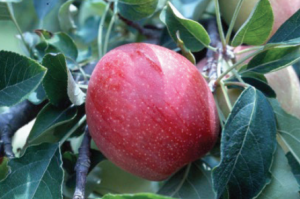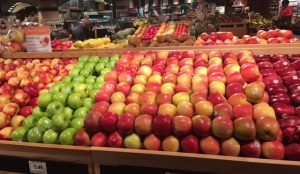
by Melanie Taylor | Sep 22, 2020
As I write this article it is the first day of Fall. Many people are enjoying the cooler temperatures, school is in full swing, a few trees are changing colors and everyone is adjusting to shorter days. As Fall begins and we move forward through this unusual and stressful year, many of us need to focus on healthier lifestyles and eating well to be our best self.
Many of us know that fresh fruits and vegetables should be a staple in our daily diets. Apples ripen and are ready for harvest in September or October, making October National Apple Month. So be sure to eat a crisp apple on a nice Fall day. They are refreshing, and you can find ones that are sweet or tart for anyone’s taste buds. They are also a low-calorie food. One medium apple only has about 80 calories. Apples are also a great source of fiber, especially if you eat the peel, and a good source of vitamin C and potassium.

Apple Time
Photo Source: UF/IFAS
Selecting Apples: When selecting apples, they should be smooth skinned, crisp, juicy and a nice color for the variety. Handle apples gently to avoid bruising. Over 2,500 varieties of apples are grown in the United States, and around 100 varieties are grown commercially. Commercially grown apples will be what you see sold in most grocery stores.
Storing Apples: Apples will remain crisp and juicier longer if refrigerated. Store refrigerated apples in plastic bags with small air holes to maintain a high moisture level and delay withering. When storing apples in the refrigerator, they will last 6-8 weeks. Apples stored at room temperature typically last less than a week and lose their crispiness.
Preparing Apples: Simply rinse, refrigerate and enjoy. The best way to prepare your apples is to rinse them under cool tap water and dry with a paper towel. You may use a vegetable brush if you feel it needs more cleaning. Know that when apples arrive to the packing facility, they are washed to remove any dirt from the orchard, but you still need to rinse them. Apples can be cooked, canned, dried and frozen. Be sure to check out some healthy apple recipes from Michigan Apples, and The American Heart Association and preservation recipes from The University of Georgia.
Be sure to enjoy some delicious apples this October!
Sources:
American Heart Association https://www.heart.org
Michigan Applies https://www.michiganapples.com
So Easy to Preserve https://nchfp.uga.edu/
Food and Fitness from Harvest to Health http://missourifamilies.org/
by Laurie Osgood | Oct 26, 2017

Apples are an ancient fruit, grown for thousands of years, and belong to the Rose family of plants. The Rose family also includes plums, raspberries, cherries, peaches, pears, and almonds.
According to Professor Peter C. Andersen, UF/IFAS Horticultural Sciences Department at the North Florida Research and Education Center in Quincy, the basics of apple growing haven´t changed much over the centuries. Although many homeowners in north Florida can grow apple trees, there is little potential for establishment of commercial apple orchards in Florida. Andersen says apples are difficult to grow in north Florida due to high rainfall, humidity, and insects during the apple-ripening season, which is late May through August. Apples need a chill period in order to set buds in the spring. Without a sufficient chill period, the apple tree will not cultivate. For more information on Florida apple varieties, check out Low-Chill Apple Cultivars for North Florida and North Central Florida.
Luckily, there are more than 8,000 varieties of apples grown worldwide, so you can still enjoy a selection of apples in north Florida, even if you aren’t able to grow them yourself.
Fun Apple Facts:
- Apples are very nutritious, especially when you eat the whole apple. The majority of the apple’s nutrients are in its skin.
- Apples are a good source of fiber and vitamin C and do not contain sodium, fat, or cholesterol.
- Apples ripen much faster at room temperature than if they are refrigerated.
- It takes about 36 apples to create one gallon of apple cider.
Apple Varieties:
Every type of apple has a distinct color, texture, and taste. There are more than 8,000 variations of apples grown worldwide. Here are some of the more well-known apples that are grown in the United States:
| Red Delicious |
This apple is grown in Iowa and is known for its deep red color and mild sweetness. The Red Delicious apple is finest when eaten whole or chopped up into salads. |
| Granny Smith |
This variety has a thick, green exterior with a sour taste. It is firm, crisp, and juicy inside and is best used for baking into pies and other baked goods. |
| Gala |
This variety has a waxy red and yellow skin with a golden interior. Its tart taste is ideal for baking or just eating. |
| McIntosh |
This apple grows abundantly in New England. McIntosh apples are crisp and juicy at their peak, but tend to soften quickly. This variety can be eaten off the tree or made into apple cider. |
| Golden Delicious |
This variety has a soft yellow skin and sweet flavor. This is considered an all-purpose apple that is ideal for snacking and cooking. |
| Empire: |
Empire apples are named for its home state of New York and is a mixture of a red delicious and a McIntosh apple. The Empire apple is crunchy and has a sweet taste, however, its texture changes quickly with extended storage, so it’s best eaten at its peak of freshness. |
Cooper, Emily. “Apples, a Bushel and a Peak of Flavor.” Food and Nutrition, 2017, pp. 28–29.
There are many other varieties of apples, and all are incredibly good for you. For the greatest benefits, eat the whole fruit — both skin and flesh.
To learn more about apples and their health benefits and healthy eating, please visit UF/IFAS Extension Solutions for Your Life or the USDA SNAP-Ed Connection.



